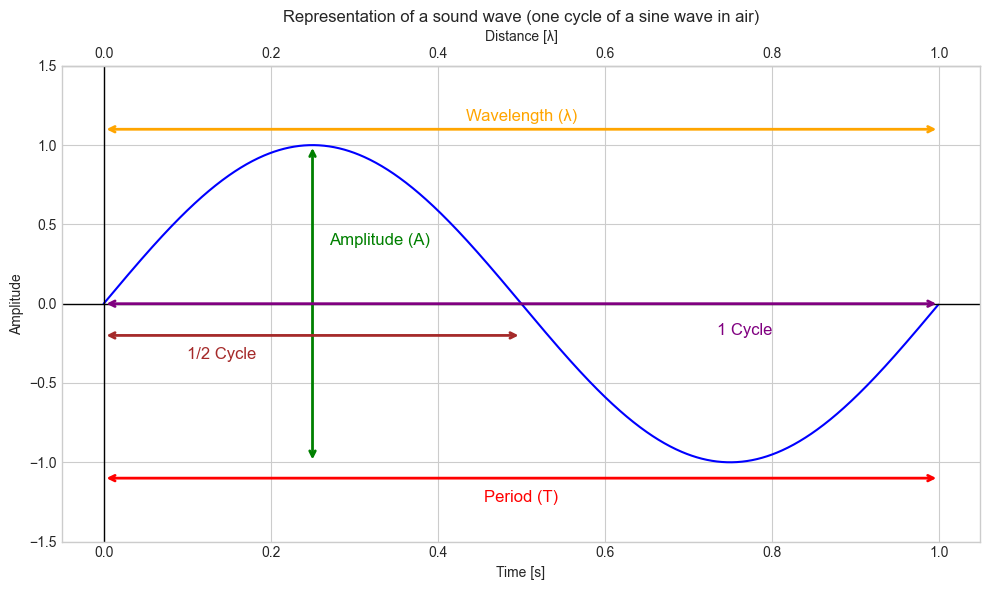Sound Waves#
import numpy as np
import matplotlib.pyplot as plt
import pandas as pd
plt.style.use('seaborn-v0_8-whitegrid')
plt.rcParams['axes.grid'] = True
np.random.seed(42)
---------------------------------------------------------------------------
ModuleNotFoundError Traceback (most recent call last)
Cell In[1], line 1
----> 1 import numpy as np
2 import matplotlib.pyplot as plt
3 import pandas as pd
ModuleNotFoundError: No module named 'numpy'
# Define sine wave parameters
A = 1 # Amplitude
f = 1 # Frequency in Hz (1 cycle per second)
T = 1 / f # Period (seconds per cycle)
λ = T # Wavelength (assuming speed of wave = 1 unit/s)
# Time vector for one cycle
t = np.arange(0, T, 1/1000)
y = A * np.sin(2 * np.pi * f * t)
# Create figure and axis
fig, ax = plt.subplots(figsize=(10, 6))
# Time domain plot
ax.plot(t, y, 'b', label=r'$y(t) = A \sin(2\pi ft)$')
ax.set_xlabel('Time [s]')
ax.set_ylabel('Amplitude')
ax.set_title('Representation of a sound wave (one cycle of a sine wave in air)')
# Add secondary x-axis for distance
secax = ax.secondary_xaxis('top', functions=(lambda x: x / λ, lambda x: x * λ))
secax.set_xlabel('Distance [λ]')
# Adjust y-limits to make space for annotations
ax.set_ylim(-1.5, 1.5)
# --- Annotations ---
# Amplitude annotation (Vertical arrow from -A to A)
ax.annotate('', xy=(T/4, A), xytext=(T/4, -A),
arrowprops=dict(arrowstyle='<->', color='green', lw=2))
ax.text(T/4 + 0.02, 0.4, 'Amplitude (A)', color='green', fontsize=12, va='center')
# Period annotation (Horizontal arrow BELOW the x-axis)
ax.annotate('', xy=(0, -1.1), xytext=(T, -1.1),
arrowprops=dict(arrowstyle='<->', color='red', lw=2))
ax.text(T/2, -1.25, 'Period (T)', color='red', fontsize=12, ha='center')
# Wavelength annotation (Horizontal arrow ABOVE the upper x-axis)
ax.annotate('', xy=(0, 1.1), xytext=(λ, 1.1),
arrowprops=dict(arrowstyle='<->', color='orange', lw=2))
ax.text(λ/2, 1.15, 'Wavelength (λ)', color='orange', fontsize=12, ha='center')
# 1-cycle annotation (Horizontal arrow BELOW the period annotation)
ax.annotate('', xy=(0, 0), xytext=(T, 0),
arrowprops=dict(arrowstyle='<->', color='purple', lw=2))
ax.text(0.8, -0.2, '1 Cycle', color='purple', fontsize=12, ha='right')
# Half-cycle annotation (Horizontal arrow BELOW the 1-cycle annotation)
ax.annotate('', xy=(0, -0.2), xytext=(T/2, -0.2),
arrowprops=dict(arrowstyle='<->', color='brown', lw=2))
ax.text(0.1, -0.35, '1/2 Cycle', color='brown', fontsize=12, ha='left')
# Formatting
ax.axhline(0, color='black', linewidth=1)
ax.axvline(0, color='black', linewidth=1)
plt.tight_layout()
plt.show()

Frequency (\(f\)) is a crucial parameter. It tells us how many cycles of the waveform occur in one second.
It’s the inverse of the period (\(T\)), where \(T\) is the time taken for one complete cycle. The relationship between frequency and period is given by: $\( f = \frac{1}{T} \quad \text{and} \quad T = \frac{1}{f} \)$
Wavelength is calculated using the speed of sound \( c_{air} = 343 m/s\) and the frequency of the sound wave. The relationship between wavelength and frequency is given by:
\[
\lambda = \frac{c_{air}}{f}
\]
# Data for frequency and corresponding wavelengths
frequencies = [
20, 25, 31.5, 40, 50, 63, 80, 100, 125, 160, 200, 250, 315, 400, 500, 630,
800, 1000, 1250, 1600, 2000, 2500, 3150, 4000, 5000, 6300, 8000, 10000, 12500,
16000, 20000
]
wavelengths = [
17.15, 13.72, 10.90, 8.58, 6.86, 5.44, 4.29, 3.43, 2.75, 2.14, 1.72, 1.37,
1.09, 0.86, 0.69, 0.54, 0.43, 0.34, 0.27, 0.21, 0.17, 0.14, 0.11, 0.086,
0.069, 0.054, 0.043, 0.034, 0.027, 0.021, 0.017
]
# Create DataFrame
df = pd.DataFrame({
'Frequency (Hz)': frequencies,
'Wavelength (m)': wavelengths
})
# Display the table
df
| Frequency (Hz) | Wavelength (m) | |
|---|---|---|
| 0 | 20.0 | 17.150 |
| 1 | 25.0 | 13.720 |
| 2 | 31.5 | 10.900 |
| 3 | 40.0 | 8.580 |
| 4 | 50.0 | 6.860 |
| 5 | 63.0 | 5.440 |
| 6 | 80.0 | 4.290 |
| 7 | 100.0 | 3.430 |
| 8 | 125.0 | 2.750 |
| 9 | 160.0 | 2.140 |
| 10 | 200.0 | 1.720 |
| 11 | 250.0 | 1.370 |
| 12 | 315.0 | 1.090 |
| 13 | 400.0 | 0.860 |
| 14 | 500.0 | 0.690 |
| 15 | 630.0 | 0.540 |
| 16 | 800.0 | 0.430 |
| 17 | 1000.0 | 0.340 |
| 18 | 1250.0 | 0.270 |
| 19 | 1600.0 | 0.210 |
| 20 | 2000.0 | 0.170 |
| 21 | 2500.0 | 0.140 |
| 22 | 3150.0 | 0.110 |
| 23 | 4000.0 | 0.086 |
| 24 | 5000.0 | 0.069 |
| 25 | 6300.0 | 0.054 |
| 26 | 8000.0 | 0.043 |
| 27 | 10000.0 | 0.034 |
| 28 | 12500.0 | 0.027 |
| 29 | 16000.0 | 0.021 |
| 30 | 20000.0 | 0.017 |


